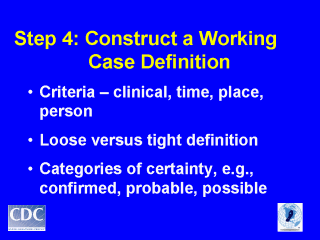| front |1 |2 |3 |4 |5 |6 |7 |8 |9 |10 |11 |12 |13 |14 |15 |16 |17 |18 |19 |20 |21 |22 |23 |review |
 |
Standard case definition is essential so that all cases are classified the same way regardless of where they occur and who the investigators are. Criteria – not only clinical features, but for outbreak need to specify time (have far back do you go to say that a case was part of this outbreak?), geographic area (only this community? County? State?), occasionally personal characteristic (e.g., 5 years of age and under). Loose (sensitive) versus tight (specific) case definition – often looser early to capture as many possible cases as possible, then may narrow. Sensitive case definition better for more complete case finding. Specific case definition better for analytic study (e.g., case-control study) to reduce bias. Note that, at CDC, “case” refers to a disease or condition, not a person. A person with the disease is usually called a “case-patient.” |